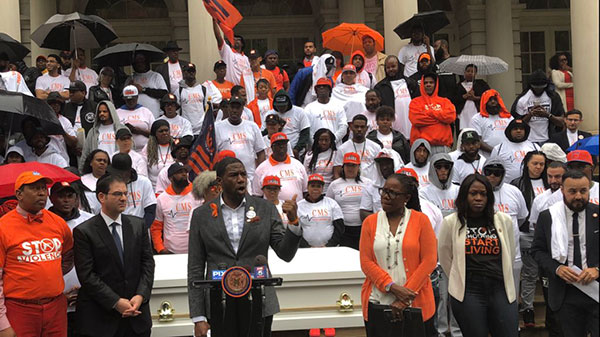
Jumaane Williams, co-author, center (photo: @JumaaneWilliams)
Throughout June, we observed Gun Violence Awareness Month. In the year since we last marked this occasion, 33,000 people lost their lives to gun violence in this country. A mass shooting of four or more casualties occurred nearly every day of that year, and just last week, five people were killed and two injured as a shooter opened fire on an Annapolis newsroom. Over the course of the month about 3,000 people were killed. Over 200 were children.
The statistics are staggering, but at the same time, we have come, over time, to acknowledge and accept this carnage as part of American life. No one can deny it -- we are, in fact, well aware of the plague of gun violence in America.
Yet while this past year has seen death and heartbreak on a massive scale, it has also been marked by a heightened, sustained awareness of the problem that extends beyond the headlines and the evening news. More than many previous years, the horrors and the causes of gun violence in this country have been spotlighted and a central part of the public consciousness. School walkouts and the March for Our Lives, driven by young people across the country, have made it clear that awareness itself is insufficient. We must continue to use this moment to propel awareness into action.
This action, of course, can take many forms. People can use their votes to demand representatives who will stand up to the NRA and other special interests, to fight for common sense gun safety measures. People have the power to make gun reform—not lip service, but real progress—a defining issue of this year’s elections. To make elected officials aware that thoughts, prayers, and passive support are not enough.
Shootings permeate every area of American life -- from churches and schools to concerts and workplaces. The vast majority of gun violence deaths, though, still stems from the daily plague of gun violence in our streets. This is the form of violence that often evades the national consciousness, but is devastating to communities.
This week, as the nation celebrates the Fourth of July, historical trends would suggest that on the ground, in certain neighborhoods, gun violence and the devastation it causes will increase. At odds with the air of celebration, this is a sobering reminder that awareness alone does not create solutions. Much of the recent awareness and attention has rightly been directed at the volume of firearms entering communities. While the availability of guns is one side of the problem we also have to consider why people use them.
Gun violence is a crisis with roots in social-structural inequality, economic distress, trauma, behavioral and public health, and when it is treated as such, we can stop the spread of the disease and combat it at its core. In cities like New York, black men are 13 times more likely to be killed in an act of gun violence than their white counterparts. These wounds—despite rarely making national news—leave a history of trauma in low-income communities of color.
And in New York City, we are relying on community to lead, activating what is known as the Crisis Management System. The Crisis Management System is a network of 50 community-based organizations attached to sites throughout the five boroughs that focus on violence interruption. The organizations employ people who have experienced many of the same things as the young people most at risk, and these violence interrupters identify and intervene in conflicts before they escalate into bloodshed. Recognizing that violence is exacerbated by social stressors, these interventions include additional supports such as job training programs, mental health services, legal aid, hospital responder programs, links to institutions of higher education, and art programming.
The approach is working.
In 2017, the city saw its lowest rates of violence since the 1950s, with a significantly greater drop in areas targeted by Cure Violence than the citywide average. There is much work to be done, but these successes show that with meaningful investment of energy and resources, violence can be prevented and lives saved.
As Congress refuses to take up the fight to end gun violence, community activists and their organizations are on the streets, effecting vital, incremental change. Just as Americans must continue to push their representatives in Congress toward gun violence solutions, they need also to work within their towns and cities to support local voices, groups, and movements, to demand the kind of reforms that we know can have a meaningful impact on the pervasive epidemic that is gun violence.
We are aware of gun violence. When not in our streets it is on our screens, America’s most predictable tragedy. This heightened awareness, raised by the wave of activism against gun violence that has swept over the country since the Parkland shooting, could too easily turn into numbness and complacency. It is imperative that we continue to feel each act of senseless violence, and work to prevent the next, moving past the month of June and carrying throughout the entire year.
***
Jumaane D. Williams is a City Council member from Brooklyn and Eric Cumberbatch is the executive director of the Mayor's Office to Prevent Gun Violence. On Twitter @JumaaneWilliams and @NYCMayorsOffice.
***
Have an op-ed idea or submission for Gotham Gazette? Email This email address is being protected from spambots. You need JavaScript enabled to view it.